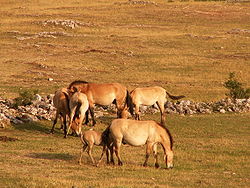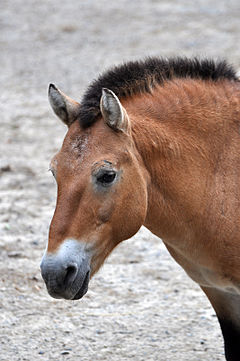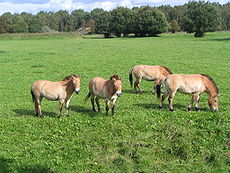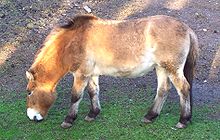- Przewalski's Horse
-
Przewalski's Horse 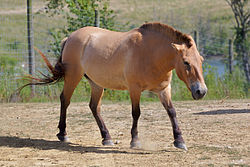
Conservation status Scientific classification Kingdom: Animalia Phylum: Chordata Class: Mammalia Order: Perissodactyla Family: Equidae Genus: Equus Subgenus: E. (Equus) Species: E. ferus Subspecies: E. f. przewalskii Trinomial name Equus ferus przewalskii
(Poliakov, 1881)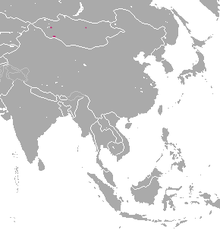
Przewalski's Horse range
(reintroduced)Synonyms hagenbecki Matschie, 1903
prjevalskii Ewart, 1903
typicus Hilzheimer, 1909Przewalski's Horse (Pronounced Sheh-VAL-ski;
 /ʃɨˈvælski/ or /zɨˈvɑːlskiː/; Polish: [pʂɛˈvalski]; Equus ferus przewalskii, Mongolian: Тахь, Takhi)[2] or Dzungarian Horse, is a rare and endangered subspecies of wild horse (Equus ferus) native to the steppes of central Asia, specifically China and Mongolia.[3] At one time extinct in the wild, it has been reintroduced to its native habitat in Mongolia at the Khustain Nuruu National Park, Takhin Tal Nature Reserve and Khomiin Tal.[1] The taxonomic position is still debated, and some taxonomists treat Przewalski's Horse as a species, Equus przewalskii. In China, the last wild Przewalski's horses were seen in 1966. The Przewalski's Horse Reintroduction Project of China was initiated in 1985 with the creation of the Xinjiang Wild Horse Breeding Center.
/ʃɨˈvælski/ or /zɨˈvɑːlskiː/; Polish: [pʂɛˈvalski]; Equus ferus przewalskii, Mongolian: Тахь, Takhi)[2] or Dzungarian Horse, is a rare and endangered subspecies of wild horse (Equus ferus) native to the steppes of central Asia, specifically China and Mongolia.[3] At one time extinct in the wild, it has been reintroduced to its native habitat in Mongolia at the Khustain Nuruu National Park, Takhin Tal Nature Reserve and Khomiin Tal.[1] The taxonomic position is still debated, and some taxonomists treat Przewalski's Horse as a species, Equus przewalskii. In China, the last wild Przewalski's horses were seen in 1966. The Przewalski's Horse Reintroduction Project of China was initiated in 1985 with the creation of the Xinjiang Wild Horse Breeding Center.Common names for this equine include Asian Wild Horse and Mongolian Wild Horse. Historical but obsolete names include true tarpan[4] and Mongolian tarpan. The horse is named after the Russian geographer and explorer Nikolai Przhevalsky.
Most "wild" horses today, such as the American Mustang or the Australian Brumby, are actually feral horses descended from domesticated animals that escaped and adapted to life in the wild. In contrast, Przewalski's Horse has never been successfully domesticated and remains a truly wild animal today. Przewalski's Horse is one of two known subspecies of Equus ferus, the other being the extinct Tarpan (Equus ferus ferus). The Przewalski's Horse is considered the only remaining truly wild "horse" in the world and may be the closest living wild relative of the domesticated horse, Equus caballus. There are still a number of other wild equines, including three species of zebra and various subspecies of the African wild ass, onager and kiang.
Contents
Taxonomy
The Przewalski's Horse was described in 1881 by L.S. Poliakov. The taxonomic position of Przewalski's Horse has always been problematic and no consensus exists whether it is a full species (Equus przewalskii), a subspecies of the wild horse (Equus ferus przewalskii) or even a sub-population of the horse (Equus ferus).[5][6][7] Studies using DNA have been inconclusive, in part due to crossing domestic horses into the Przewalski's Horse as well as the limited genetic variation present in the founder population of the Przewalski's Horse. A 2009 molecular study using ancient DNA (that is DNA recovered from archaeological finds like bones and teeth) places the Przewalski's Horse in the middle of the domesticated horses,[7] but more recent mitochondrial DNA analysis suggests that the Przewalski and the modern domestic horse diverged some 160,000 years ago.[8]
Population
The world population of these horses are all descended from 9 of the 31 horses in captivity in 1945.[9] These nine horses were mostly descended from approximately 15 captured around 1900. A cooperative venture between the Zoological Society of London and Mongolian scientists has resulted in successful reintroduction of these horses from zoos into their natural habitat in Mongolia; and as of 2011 there is an estimated free-ranging population of over 300 in the wild.[10] The total number of these horses according to a 2005 census was about 1,500.[11]
Appearance
Przewalski's Horse is stockily built in comparison to domesticated horses, with shorter legs. Typical height is about 13 hands (52 inches, 132 cm), length is about 2.1 m (6 ft 11 in). They weigh around 300 kilograms (660 lb). The coat is generally dun in color with pangaré features, varying from dark brown around the mane (which stands erect) to pale brown on the flanks and yellowish-white on the belly and around the muzzle. The legs of Przewalski's Horse are often faintly striped, also typical of primitive markings.[12] The tail is about 90 cm (35.43 in) long, with a longer dock and shorter hair than seen in domesticated horses.
Behavior
In the wild, Przewalski's Horses live in social groups consisting of a dominant stallion, a dominant lead mare, other mares, and their offspring. The patterns of their daily lives exhibit horse behavior similar to that of feral horse herds. Each group has a well-defined home range; within the range, the herd travels between three and six miles a day, spending time grazing, drinking, using salt licks and dozing. At night, the herd clusters and sleeps for about four hours. Ranges of different herds may overlap without conflict, as the stallions are more protective of their mares than their territory.
Stallions practice a form of scent marking and will establish piles of dung at intervals along routes they normally travel to warn other males of their presence. In addition, when a female in the herd urinates, the stallion will frequently urinate in the same place, to signal her membership in the herd to other males. The stallions can frequently be seen sniffing dung piles to confirm scent markings.[citation needed]
History
In the 15th century, Johann Schiltberger recorded one of the first European sightings of the horses in the journal of his trip to Mongolia as a prisoner of the Mongol Khan.[13] The horse is named after the Russian colonel Nikolai Przhevalsky (1839–1888) (the name is of Polish origin and "Przewalski" is the Polish spelling). He was the explorer and naturalist who first described the horse in 1881, after having gone on an expedition to find it, based on rumors of its existence. Many of these horses were captured around 1900 by Carl Hagenbeck and placed in zoos. As noted above, about twelve to fifteen reproduced and formed today's population.
The native population declined in the 20th century due to a combination of factors, with the wild population in Mongolia dying out in the 1960s. The last herd was sighted in 1967 and the last individual horse in 1969. Expeditions after this failed to locate any horses, and the species was designated "extinct in the wild" for over 30 years.
After 1945 only two captive populations in zoos remained, in Munich and in Prague. The most valuable group, in Askania Nova, Ukraine, was shot by German soldiers during World War II occupation, and the group in the USA had died out.
By the end of the 1950s, only 12 individual Przewalski horses were left in the world.[14]
In 1977, the Foundation for the Preservation and Protection of the Przewalski Horse was founded in Rotterdam, the Netherlands, by Jan and Inge Bouman, which started a program of exchange between captive populations in zoos throughout the world to reduce inbreeding, and later starting a breeding program of its own. As a result of such efforts, the extant herd has retained a far greater genetic diversity than its genetic bottleneck made likely.[14]
In 1992, sixteen horses were released into the wild in Mongolia, followed by additional animals later on. One of the areas to which they were reintroduced became Khustain Nuruu National Park in 1998. Another reintroduction site is Great Gobi B Strictly Protected Area, located at the fringes of the Gobi desert.
The reintroduced horses successfully reproduced, and the status of the animal was changed from "extinct in the wild" to "endangered" in 2005.[11] On the IUCN Red List, they were reclassified from "extinct in the wild" to "critically endangered" after a reassessment in 2008[15] and from "critically endangered" to "endangered" after a 2011 reassessment.[10]
Preservation efforts
While dozens of zoos worldwide have Przewalski's Horses in small numbers, there are also specialized reserves dedicated primarily to the species.
The world's largest captive breeding program for Przewalski's horses is at the Askania Nova preserve in Ukraine. Several dozen Przewalski's horses were also released in the area evacuated after the Chernobyl accident, which now serves as a deserted de facto natural preserve.[16] An intensely researched population of free-ranging animals was also introduced to the Hortobágy puszta in Hungary; data on social structure, behavior, and diseases gathered from these animals is used to improve the Mongolian conservation effort.
Several American zoos also collaborated in breeding Equus ferus przewalskii from 1979 to 1982.[17] Recent advances in equine reproductive science in the USA also have potential to further preserve and expand the gene pool. In October 2007, scientists at the Smithsonian Institution's National Zoo successfully reversed a vasectomy on a Przewalski horse — the first operation of its kind on this species and possibly the first ever on any endangered species. While normally a vasectomy may be performed on an endangered animal under limited circumstances, particularly if an individual has already produced many offspring and its genes are overrepresented in the population, scientists realized the animal in question was one of the most genetically valuable Przewalski horses in the North American breeding program.[18]
The Przewalski's Horse Reintroduction Project of China was initiated in 1985 when the country introduced 11 wild horses from overseas. After more than two decades of dedicated efforts, the Xinjiang Wild Horse Breeding Center managed to breed a large number of the horses, of which 55 were let loose into the Kalamely Mountain area. The animals quickly adapted to their new environment. In 1988, six foals were born and survived. In 2001 there were over 100 horses at the center. Now both their reproduction rate and survival rate are the highest in the world.[citation needed]
See also
- Konik
- Dzungarian Gate
- Feral horse
- Mongolian domestic horse
- Mongolian Wild Ass
- Reintroduction
- Wild horse
Notes
- ^ a b Boyd, L.; Zimmermann, W. & King, S.R.B (2008). "Equus ferus ssp. przewalskii". 2008 IUCN Red List of Threatened Species.. IUCN. http://www.iucnredlist.org/apps/redlist/details/7961/0/full. Retrieved February 1, 2009.
- ^ "The Takhi". International Takhi-Group. http://www.savethewildhorse.org/takhi.html. Retrieved October 25, 2010.
- ^ Grubb, Peter (16 November 2005). "Order Perissodactyla (pp. 629-636)". In Wilson, Don E., and Reeder, DeeAnn M., eds. Mammal Species of the World: A Taxonomic and Geographic Reference (3rd ed.). Baltimore: Johns Hopkins University Press, 2 vols. (2142 pp.). p. 630-631. ISBN 978-0-8018-8221-0. OCLC 62265494. http://www.bucknell.edu/msw3/browse.asp?id=14100018.
- ^ William Ridgeway (1908). "Environment and race". The Geographical Journal (Royal Geographical Society.) 32 (4): 405–412. doi:10.2307/1776930. JSTOR 1776930. http://books.google.com/?id=MqgMAAAAIAAJ&pg=PA407&dq=tarpan., page 407
- ^ lau, Allison; Lei Peng, Hiroki Goto, Leona Chemnick, Oliver A. Ryder, Kateryna D. Makova (2009). "Horse Domestication and Conservation Genetics of Przewalski’s Horse Inferred from Sex Chromosomal and Autosomal Sequences". Mol. Biol. Evol. 26 (1): 199–208. doi:10.1093/molbev/msn239. PMID 18931383.
- ^ Kavar, Tatjana; Peter Dovč (2008). "Domestication of the horse: Genetic relationships between domestic and wild horses". Livestock Science 116: 1–14. doi:10.1016/j.livsci.2008.03.002.
- ^ a b Cai, Dawei; Zhuowei Tang, Lu Han, Camilla F. Speller, Dongya Y. Yang, Xiaolin Ma, Jian’en Cao, Hong Zhu, Hui Zhou (2009). "Ancient DNA provides new insights into the origin of the Chinese domestic horse". Journal of Archaeological Science 36 (3): 835–842. doi:10.1016/j.jas.2008.11.006.
- ^ O A Ryder, A R Fisher, B Schultz, S Kosakovsky Pond, A Nekrutenko, K D Makova. "A massively parallel sequencing approach uncovers ancient origins and high genetic variability of endangered Przewalski's horses". Genome Biology and Evolution. 2011
- ^ Boyd, Lee. (1994). Przewalski's Horse, p. 1.
- ^ a b "Another leap towards the Barometer of Life". International Union for the Conservation of Nature. 10 November 2011. http://www.iucn.org/about/work/programmes/species/red_list/?8548/Another-leap-towards-the-Barometer-of-Life.
- ^ a b "An extraordinary return from the brink of extinction for worlds last wild horse" ZSL Living Conservation, December 19, 2005.
- ^ National Zoo information on Przewalski's Horse
- ^ Breeds of Livestock - Przewalski Horse
- ^ a b O A Ryder et al, ibid
- ^ IUCN Red List - Equus ferus
- ^ Mulvey, Stephen (April 20, 2006). "Wildlife defies Chernobyl radiation". BBC News. http://news.bbc.co.uk/2/hi/europe/4923342.stm. Retrieved October 3, 2007.
- ^ Oliver A. Rydera and Elizabeth A. Wedemeyera, "A cooperative breeding programme for the Mongolian wild horse Equus przewalskii in the United States," Biological Conservation, Volume 22, Issue 4, April 1982, pp. 259-271, abstract found at Science Direct website. Accessed February 24, 2010.
- ^ "Zoo Performs First Reverse Vasectomy on Horse" The Horse online edition, citing Associated Press, June 17, 2008.
References
- Boyd, Lee and Katherine A. Houpt. (1994). Przewalski's Horse: The History and Biology of an Endangered Species. Albany, New York: State University of New York Press. 10-ISBN 0-791-41889-8; 13-ISBN 978-0-791-41889-5; OCLC 28256312
- Forestry Commission. 2004. FC Wales turns clock back thousands of years with 'wild' solution to looking after ancient forest site. News release, No: 7001, September 16, 2004. [1]
- International Commission on Zoological Nomenclature. 2003. Opinion 2027 (Case 3010). Usage of 17 specific names based on wild species which are pre-dated by or contemporary with those based on domestic animals (Lepidoptera, Osteichthyes, Mammalia): conserved. Bull.Zool.Nomencl., 60:81-84. [2].
- Ishida, Nobushige; et al. (1995). "Mitochondrial DNA sequences of various species of the genus Equus with special reference to the phylogenetic relationship between Przewalskii's wild horse and domestic horse". Journal of Molecular Evolution 41 (2): 180–188. doi:10.1007/BF00170671. PMID 7666447.
- Jansen, Thomas; et al. (2002). "Mitochondrial DNA and the origins of the domestic horse". PNAS 99 (16): 10905–10910. doi:10.1073/pnas.152330099. PMC 125071. PMID 12130666. http://www.pubmedcentral.nih.gov/articlerender.fcgi?tool=pmcentrez&artid=125071.
- King, S. R. B.; Gurnell, J. (2006). "Scent-marking behaviour by stallions: an assessment of function in a reintroduced population of Przewalski horses (Equus ferus przewalskii)". Journal of Zoology 272 (1): 30–36. doi:10.1111/j.1469-7998.2006.00243.x.
- Wakefield, S., Knowles, J., Zimmermann, W. and Van Dierendonck, M. 2002. "Status and action plan for the Przewalski's Horse (Equus ferus przewalski)". In: P.D. Moehlman (ed.) Equids: Zebras, Asses and Horses. Status Survey and Conservation Action Plan, pp. 82–92. IUCN/SSC Equid Specialist Group. IUCN, Gland, Switzerland and Cambridge, UK. [3]
- Wilford, John Noble (October 11, 2005). "Foal by Foal, the Wildest of Horses Is Coming Back". New York Times. http://www.nytimes.com/2005/10/11/science/11hors.html.
- [4]
- http://www.china.org.cn/english/environment/237442.htm
- Cao Jie, Przewalski's Horse Reintroduction Project of China
- Przewalski's Horse - Equus ferus przewalskii; IUCN/SSC Equid Specialist Group; Species Survival Groups ([5])
External links
- ARKive - images and movies of the Przewalski's horse (Equus ferus przewalskii)
- Details of the re-introduction program for Przewalski's horse.
- Umbrella organization of all institutions participating in the reintroduction of takhis in Mongolia
- General studbook of Przewalski's horse
- [6]
Extant Perissodactyla (Odd-toed ungulates) species by suborder Kingdom Animalia · Phylum Chordata · Class Mammalia · Infraclass Eutheria · Superorder LaurasiatheriaHippomorphaEquidae
(Horse family)Subgenus Equus: Wild horse (E. ferus) · Domestic Horse (E. ferus caballus)
Subgenus Asinus: African Wild Ass (E. africanus) · Donkey (E. asinus) · Onager (E. hemionus) · Kiang (E. kiang)
Subgenus Dolichohippus: Grévy's Zebra (E. grevyi)
Subgenus Hippotigris: Plains Zebra (E. quagga) · Mountain Zebra (E. zebra)CeratomorphaRhinocerotidae
(Rhinoceroses)Tapiridae
(Tapirs)Species of the genus Equus Extinct species are marked †Equus africanus · Equus africanus africanus · Equus africanus asinus · †Equus africanus atlanticus · Equus africanus somaliensis · †Equus complicatus · †Equus conversidens · †Equus crinidens · †Equus cumminsii · †Equus excelsus · Equus ferus · Equus ferus caballus · †Equus ferus ferus · Equus ferus przewalskii · †Equus francisci · †Equus fraternus · †Equus giganteus · Equus grevyi · Equus hemionus · Equus hemionus hemionus · †Equus hemionus hemippus · Equus hemionus khur · Equus hemionus kulan · Equus hemionus luteus · Equus hemionus onager · †Equus hydruntinus · Equus kiang · Equus kiang chu · Equus kiang holdereri · Equus kiang kiang · Equus kiang polyodon · †Equus lambei · †Equus namadicus · †Equus niobrarensis · †Equus occidentalis · †Equus pacificus · †Equus parastylidens · †Equus pectinatus · Equus quagga · Equus quagga burchellii · Equus quagga boehmi · Equus quagga borensis · Equus quagga chapmani · Equus quagga crawshayi · †Equus quagga quagga · †Equus scotti · †Equus simplicidens · †Equus sivalensis · †Equus stenonis · †Equus yunnanensis · Equus zebra · Equus zebra hartmannae · Equus zebra zebraCategories:- IUCN Red List endangered species
- Fauna of Mongolia
- Natural history of Central Asia
- Natural history of China
- Living fossils
- Animals described in 1881
- Horse subspecies
Wikimedia Foundation. 2010.
Look at other dictionaries:
Przewalski's horse — [pshə väl′skēz, shəväl′skēz] n. a small, strong wild horse (Equus caballus przewalskii) of Mongolia, characterized by a large head, a short, erect mane, and a light bay color … English World dictionary
Przewalski's horse — /psheuh vahl skeez, sheuh / a wild horse, Equus caballus przevalskii, chiefly of Mongolia and Sinkiang, characterized by light yellow coloring and a stiff, upright black mane with no forelock: the only remaining breed of wild horse, it is now… … Universalium
Przewalski’s horse — , Przewalski’s gazelle Two rare species, both named for Nikolai Przewalski (or Przhevalsky), Russian explorer (1839–1888) … Bryson’s dictionary for writers and editors
Przewalski's horse — Prze•wal′ski s horse′ [[t]pʃəˈvɑl skiz, ʃə [/t]] n. zool. mam a wild horse, Equus caballus przevalskii, chiefly of Mongolia and Xinjiang, having a light yellow coat and a short, stiff black mane • Etymology: after Nikolaĭ Mikhaĭlovich Przheval… … From formal English to slang
Przewalski's horse — noun A rare, endangered horse, Equus ferus przewalskii, native to the steppes of Central Asia. Syn: Asian wild horse, Dzungarian horse, Mongolian wild horse … Wiktionary
Przewalski's horse — noun wild horse of central Asia that resembles an ass; now endangered • Syn: ↑Przevalski s horse, ↑Equus caballus przewalskii, ↑Equus caballus przevalskii • Hypernyms: ↑wild horse … Useful english dictionary
Przewalski's horse — noun Etymology: Nikolaĭ M. Przhevalskiĭ died 1888 Russian soldier & explorer Date: 1881 a small stocky bay or dun colored wild horse (Equus caballus przewalskii syn. E. przewalskii) of central Asia having a large head and short erect mane and now … New Collegiate Dictionary
Przewalski's horse — /prəwɒlskiz ˈhɔs/ (say pruhwolskeez haws), /prəwælskiz/ (say pruhwalskeez), /pəʃəvalskiz/ (say puhshuhvahlskeez) noun an ancient species of wild horse from Mongolia, Equus przevalskii Poliakov, being short and sturdy with a dun coloured coat,… …
Przewalski-Pferd — (Equus ferus przewalskii) Systematik Überordnung: Laurasiatheria Ordnung … Deutsch Wikipedia
Przewalski-Wildpferd — Przewalski Pferd Przewalski Pferd (Equus ferus przewalskii) Systematik Überordnung: Laurasiatheria … Deutsch Wikipedia


